
Botox injections around the eyes - the procedure is as widespread and in demand as causing concern. At a minimum, many patients are afraid of direct needle damage to the eye or visual impairment due to the effect of injections on the muscles that control the eyeballs. Even more often they fear that the undesirable consequences of Botox injections will turn out to be more noticeable and even more likely to spoil the appearance than the wrinkles themselves, to combat which the procedure is carried out.
We note right away that in most cases, such fears are unfounded and are often caused by various misconceptions, anti-advertising, and reviews of unsuccessful procedures, in which side effects are caused not so much by Botox action as by the doctor’s mistakes, and often violations of the rehabilitation regimen by the patient himself. In reality, injecting Botox around the eyes is not more dangerous than injecting into the forehead or, say, into the lips.
However, some cosmetological problems in this area can be solved only by Botox. For example, to remove “crow's feet” or small dynamic wrinkles under the eyes, to correct the asymmetry of the opening of the palpebral fissures - these are tasks that, apart from botulinum therapy, can only be solved by means of plastic surgery, and even then not always. Therefore, in many cases, to obtain the desired cosmetic effect, injecting Botox around the eyes is necessary. Along with this, you need to know how this procedure is carried out correctly, what its temporary consequences can be observed (so as not to panic for no reason), what effects can be obtained from it, and which cannot be achieved. We invite you to clarify these issues with us.
Indications for Botox injections in the area around the eyes
In most cases, Botox and its analogues are injected into the periorbital region (around the eyes) to eliminate facial wrinkles. Since there are usually no deep creases near the eyes, botulinum therapy is carried out here against fine wrinkles. Most often these are “crow's feet”, less often - wrinkles under the eyes, on the upper eyelid, on the walls of the nose (the so-called rabbit wrinkles). All of them are formed mainly due to the constant formation of folds on the skin when expressing certain emotions: when the skin and subcutaneous layer become thinner and weaker with age, their wrinkling is not compensated by natural elasticity and the folds persist even after the disappearance of the emotion. So there is a dynamic wrinkle.
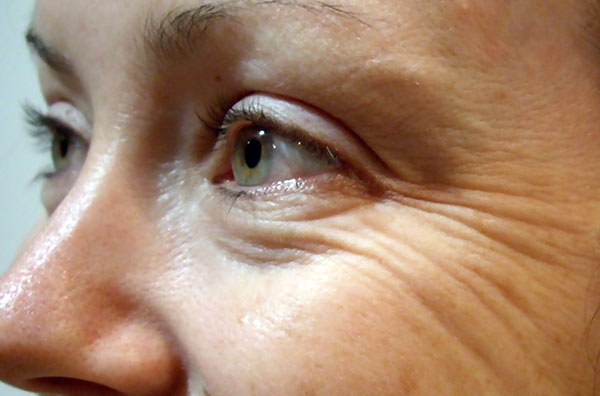
Injections of botulinum toxin can eliminate crow's feet.
It is important to be able to distinguish dynamic wrinkles near the eyes from skin defects associated with its thinning, weakening and loss of moisture. The latter are corrected not by Botox, but by the use of other cosmetic methods and means, including fillers. To understand what caused these or those wrinkles, a professional cosmetologist should.
Nevertheless, the introduction of botulinum toxin into the periorbital region is carried out not only to eliminate wrinkles. Indications for such a procedure can also be:
- Hypertrophy of the pretarsal part of the circular muscle of the eye, which leads to a narrowing of the palpebral fissure (especially with a smile) and the formation of a bag under the eye;
- Natural ptosis, as well as the slight asymmetry of opening the eye caused by it;
- Strabismus due to hyperactivity of the circular muscle;
- Hemifacial spasm.
It is important that in cosmetology clinics treatment of hemifacial spasm and strabismus is not carried out. Botox injections with these goals are done by neuropathologists, ophthalmologists or surgeons in the treatment of patients with appropriate pathologies.

Preparations containing botulinum toxin are not only used for cosmetic purposes, but, above all, for medicinal purposes.For example, Botox eliminates the problem of drooping eyelids (ptosis).
The results that can be obtained with such injections
When Botox injections around the eyes for different purposes, the complex of effects obtained is usually similar. At the same time, depending on the position of the points of administration of the drug and the amount of the drug used, the main effect will be one, and the other ones will be secondary. Often, the target effects, for which the drug is used in one case, may be undesirable in other situations.
For example, sometimes Botox is purposefully used to raise the slightly lowered upper eyelid. In other cases, it can be used to eliminate crow's feet, but in parallel, the drug will act on that part of the circular muscle of the eye, which is responsible for holding the eyelid, and lifting it will occur as a side effect of the injection. Moreover, if such a rise leads to asymmetry and unnatural opening of the palpebral fissure, it is undesirable.
On a note
The most pronounced relativity of the effects of botulinum therapy appears with the development of strabismus. If, given the strabismus caused by hypertrophy of the circular muscle, its relaxation leads to normalization of the position of the lens and pupil, then in its absence the effect of botulinum toxin on this muscle can cause a change in the position of the pupil with some visual impairment.
In this case, the main results for which Botox is injected around the eyes are:
- Smoothing the crow's feet, usually complete;
- Elimination of wrinkles under the eyes;
- Elimination of rabbit wrinkles formed on the sides of the nose with the manifestation of an emotion of disgust;
- Raising the upper eyelid or lowering the lower eyelid, enlarging the palpebral fissure (especially often patients with Mongoloid features and, accordingly, narrow eyes) go to clinics for this result. Botox can slightly "raise" the corners of the eyes. This effect can be achieved both on one eye, and on both, depending on the purpose of the procedure. If the patient has an asymmetry in the opening of the eyes, Botox is injected only near that eye, which is stronger covered. If the task is to equally increase the opening of both eyes, both sides are chipped;
- Correction of strabismus to the extent that it is due to excessive tension of the circular muscle;
- The weakening or elimination of hemifacial spasm.
The photo below shows the condition of the skin near the eyes before Botox injections and after them:

These effects are manifested on the 1-4th day after the introduction of botulinum toxin into the muscles, and the rate of manifestation of the effect depends on the amount of the drug administered and the places of its administration, as well as on the individual characteristics of the body and the severity of the defect. It should be understood that the same amounts of botulinum toxin in different people can cause effects of different strengths at different speeds.
Feedback
What's around the eyes, that in the interbrow, injecting Botox is equally safe. I have stabbed myself around my eyes three times already, three injections on each side. Nothing special, there was no pain. I’m doing so that I can slightly raise the corners of my eyes and smooth my paws, I’m very noticeable. After the injections, my eyes hurt, maybe a day or two, as after a long work at the computer. Once there were swelling under the eyes, but also quickly passed. But then the effect is simply magnificent: the eyes become expressive, large, there are no wrinkles on the sides. Specifically, my Botox rises quickly, already on the second day the effect is visible, until the side effects have ended. It also costs a long time, 8-9 months. But my doctor has patients who, on the contrary, get up for a week or two, and then end in six months. It all depends on the sensitivity. My recommendation to you: do not put Botox in the summer when it is hot and the body is hot. The tool can spread under the skin, there will be a lot of side effects. Make in winter or early spring, just spend the whole summer beautiful.
Dinara, Moscow
Duration of effect
The result obtained with Botox injections lasts from 3 to 9 months, after which it gradually disappears, and the eliminated defects appear again. Therefore, if the effect must be maintained longer, after this period the injections of the drug should be repeated.
On a note
The disappearance of the effect of Botox injections is associated with the specific reaction of the body to this remedy. After injections, botulinum toxin - the active ingredient of Botox - leads to impaired release of the neurotransmitter in the neuromuscular synapses, due to which, here, at the site of interaction of nerve cells with muscle fibers, the transmission of nerve impulses is interrupted. After that, the muscles do not contract due to the fact that they do not receive signals from the nervous system. The absence of such signals for the body is a sign of the pathology with which it begins to fight: new processes appear on the nerve cell, connecting with muscle fibers and forming synapses, along which the nerve impulse begins to be transmitted. When there are a lot of these synapses, the normal functioning of the muscle resumes, and with it the formation of wrinkles. Studies show that the process of restoration of contacts of nerve cells with muscles starts already in the first days after the introduction of botulinum toxin.
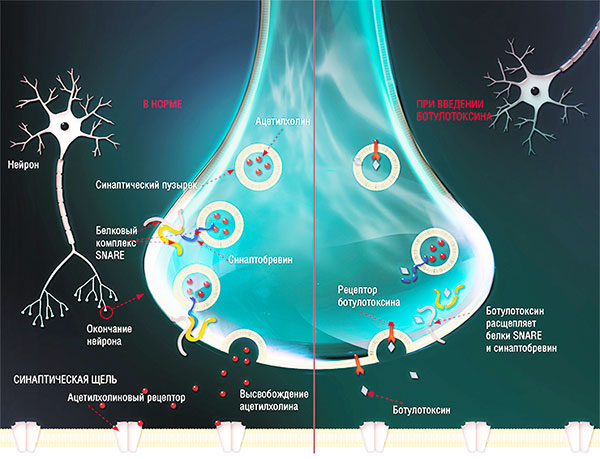
The mechanism of action of botulinum toxin.
According to various authors, the following factors affect the duration of the conservation of the Botox effect:
- The intensity of metabolism and regeneration processes in the body. The faster they are, the less lasting the Botox effect will be;
- The physical activity of the patient - the more it is, the faster the action of the drug will end. So, in professional athletes, the effect of botulinum treatment usually lasts no more than 3-4 months;
- Taking certain medications before and after injections. Such agents can stimulate regenerative processes or, conversely, slow them down;
- The patient's sensitivity to botulinum toxin in general and to a specific drug in particular. Approximately 5% of people Botox does not work at all;
- Punctuality of the patient in compliance with the rules of recovery after the procedure;
- The amount of drug administered.
It is also known that, on average, the duration of the effect after injections of Dysport (one of Botox's analogues) is shorter than that after injections of Botox, Xeomin and some other drugs. So, with an average duration of preservation of the effect of using Botox in 6-7 months, the average duration of Dysport is 5-6 months. However, much here depends on the characteristics of the organism of a particular person, and it is impossible to say that one drug is clearly better than another.
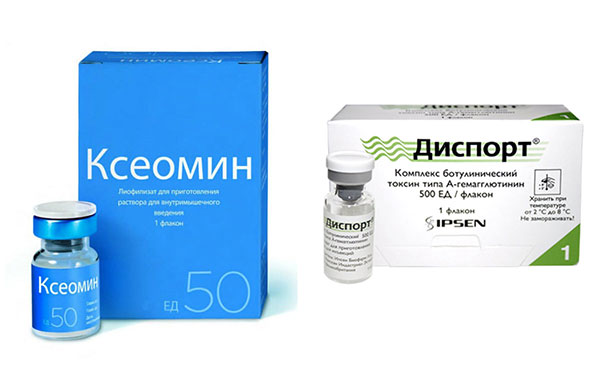
Drugs that are analogues of Botox.
Feedback
I have Botox near my eyes for 6 months, there is not even a hint of paws at this time. Then they slowly begin to appear, after just 8-9 months they’ll directly get out. The doctor advises every 9 months to do it, but I want it to be perfect, so I stab more often. Moreover, it costs 4500 along with the line between the edge and forehead - this is not a price at all.
Irina, Nizhny Novgorod
What Botox facial flaws will not fix
There are defects of the periorbital zone, which Botox will not help to cope with. These include, for example:
- Dark circles under the eyes, colloquially - bruises. Their appearance is in no way associated with muscle activity, and therefore they are not eliminated by muscle relaxants;
- The effect of sunken eyes, also not related to the activity of the eye muscles and therefore Botox cannot be eliminated;
- In some cases, characteristic bags under the eyes. Botox cannot be influenced by them if they are caused by excessive fluid intake, pathologies, the use of certain drugs;
- Dark spots;
- Wrinkles and dents caused by thinning of the skin and degradation (including age) of the subcutaneous tissue layer;
- Pronounced nasolacrimal groove.
These defects can be removed either by other means and cosmetological methods (for example, “nasal tearing” and correct static wrinkles with the help of fillers), or by a complex of these means and methods.
For example, in the photo below - typical wrinkles that Botox eliminates:

And here is the “nose-tear” and dark circles under the eyes that Botox cannot correct:
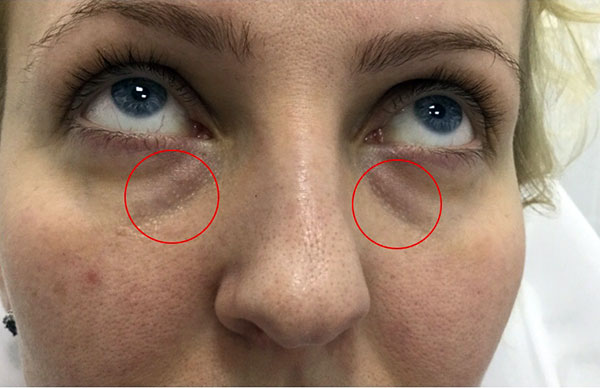
It is interesting that defects eliminated by botulinum toxin are no longer completely and qualitatively corrected by any other methods. Thus, in many cases it is impossible to find a full-fledged alternative to Botox.
Feedback
I with Botox raked in full. I did the first procedure at 50, I was very afraid, for a long time I chose a doctor to set a minimum. Obvious creases were only on the forehead and between the eyebrows. As I later discovered, there were still crow's feet, but somehow I did not pay attention to them. So, at first I decided only on the forehead and between the eyebrows, they put 8 units. In all places of injections bumps came out, solid, noticeable. Well, they went in a week, and wrinkles went with them. All is well, in general. After a year, the effect was over, but while there were no wrinkles, the paws clearly began to catch the eye. You stand in front of the mirror and only see them. In general, the second time I went to stab my forehead and eyes. Here came the tin. Cones got out on the forehead, as before, plus swelling appeared above the interbrow. But I was ready. But what happened to the eyes! One closed completely; the next morning after sleep, she could not open it at all. About two weeks it was hard to open both eyes, not only in the morning, but at any moment. You blink and you open your eyes, as if they weigh 2 kilograms. And when both opened, I discovered that one was mowing! I was not ready for this at all. I was afraid that this is now complete. I called the doctor, she laughs, reassures me, they say, everything is fine. Indeed, in a week both cones and heaviness over the centuries passed. Both eyes open equally, but the "kosinka" remained somewhere for a month. In the morning I’m directly annoying, and in the afternoon, when my eyes open, everything is fine, you don’t feel it. And yes, the main thing: Botox removes the crow's feet completely. Standard months 8 they are not at all, although the smile is normally stretched, there are no "masks".
Olga, Moscow
The real and imaginary dangers of Botox injections around the eyes
The real dangers of Botox injections around the eyes in their bulk are not much different from injections, for example, in the forehead or interbrow.
So, the standard side effects when injected into the periorbital region are:
- Edema, bruising, bumps and ecchymosis, most often occurring under the eyes. They do not require special correction and will pass independently in 2-3 days. To reduce the risk of their occurrence, ice is applied to the injection sites immediately after administration of the drug. Some doctors, for the same purpose, prescribe a tablet with extract of mountain arnica for patients to receive after the procedure. Sometimes edema under the eyes persists for a long time - up to several weeks, which is associated with immobilization of the circular muscle of the eye. In these cases, it is difficult to deal with them, but you can completely remove them only after special procedures;
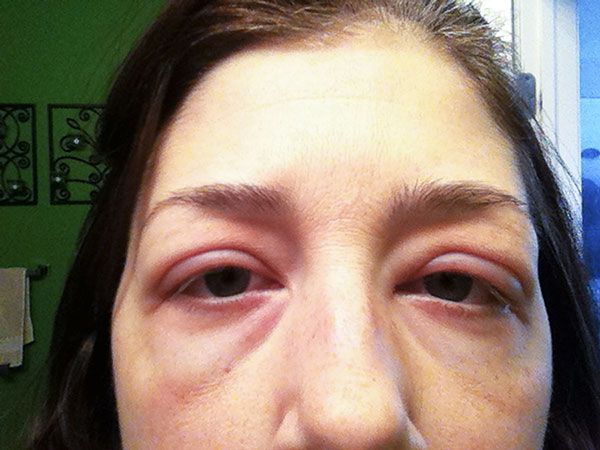
One of the side effects of botulinum toxin injections can be swelling around the eyes.
- Weakness of the lower eyelid and difficulty in closing the eyes;
- Round eye syndrome - a rare effect, which is an extreme degree of severity of the previous;
- Asymmetry of the upper eyelids, easily corrected by repeated compensatory administration of the drug into the muscle of the eye, the eyelid on which is more omitted;
- Asymmetry of eyebrows, which occurs much less often than defects of the eyelids (eyebrows are mainly affected by injections in the forehead);
- Lacrimation or, conversely, dry eyes;
- Ptosis, or omission of the upper eyelid.It occurs often enough, it cannot always be quickly adjusted, which is why it is considered the most unpleasant side effect - there are cases when patients walked with a half-closed eye for up to six months;
- Double vision, sometimes - noticeable squint. One of the most unpleasant complications that reduce the quality of life of the patient. It is difficult to correct, however, like other effects, it is temporary and ends when the drug ceases to act. It occurs extremely rarely, literally several cases of persistent strabismus are known, which persisted longer than a week after injections;
- Paresis of the muscle or an increase in existing paresis, leading to the inability to close the eye. It is dangerous and requires constant hydration of the eye.
In fairness, it should be noted that serious side effects with injections around the eyes develop extremely rarely. In some cases, doctors prefer to introduce a dose lower than required by the regulations, evaluate the effect and adverse reactions in a particular patient, and then prick the drug in a week or two to achieve the desired effect.
On a note
By itself, without being injected under or into the skin, Botox is not harmful to the eyes. Even if, during cosmetic procedures, the finished liquid preparation accidentally gets into the eye, it will not cause harm and will not affect eyesight in any way. Within a few minutes it will come out of the eye with tear fluid and will not cause any side effects - swelling, drooping of the eyelid or others.
The same dangers as an eyeball needle injury are theoretically possible, but do not happen in practice. To be afraid of such an accident is just as pointless as, for example, to be afraid of an eye injury with scissors when aligning eyelashes.
In any case, all such risks are an obvious reason to choose an experienced professional doctor for the procedure, who will be able to anticipate undesirable consequences and prevent them.
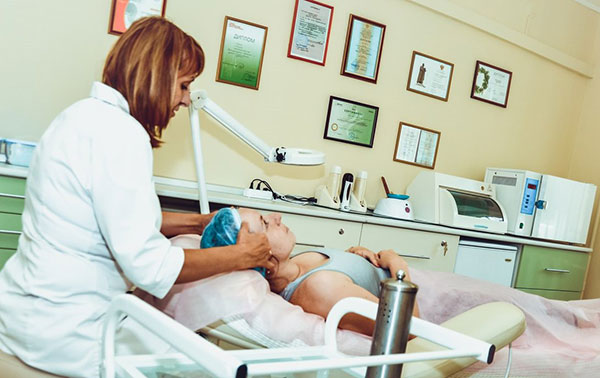
To avoid unpleasant consequences from "beauty injections", you should carefully choose a specialist for the procedure.
Contraindications to the procedure
In some conditions and pathologies, it is impossible to stab Botox around the eyes or in particular muscles. Such contraindications can be divided into universal (for botulinum therapy in general) and private, in which it is impossible to chise only the eyes, but Botox can be injected into other parts of the face or body.
Common contraindications for the procedure include:
- Allergy to botulinum toxin or auxiliary components of drugs;
- Pregnancy and lactation;
- Children's age up to 3 years;
- Infectious skin lesions in places of the alleged introduction of the drug - herpetic eruptions, fungal spots and more;
- Oncological diseases;
- Any infectious disease in the acute stage, especially with a high fever and characteristic fever;
- Taking certain medications, especially antibiotics, muscle relaxants, antidepressants;
- Diabetes;
- Myasthenia gravis;
- Other cosmetic procedures and operations performed shortly before botulinum therapy. The valid intervals here depend on the specific procedures.
In the presence of one of them, Botox can not be pricked either in the periorbital region, or at any other point on the body.
Specifically, botulinum toxin preparations can not be injected into the eye area in such conditions:
- Severe lesions and paralysis of the facial nerves;
- Ocular hernia;
- Open wounds, ulcers, fresh scars on the face in places of the alleged introduction of the drug;
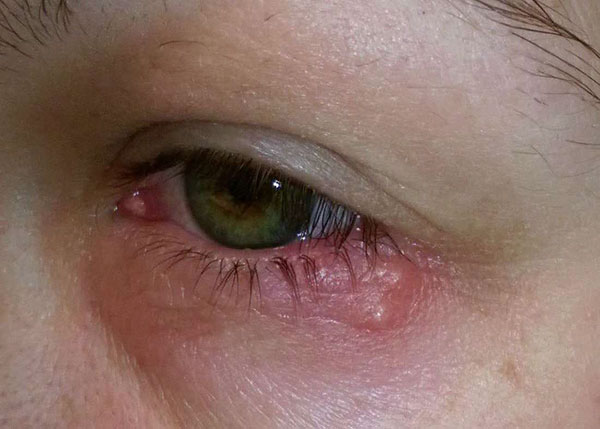
If there are wounds, ulcers on the skin around the eyes, botulinum therapy in this area is contraindicated.
- Round eye syndrome;
- Paresis, dystrophy and impaired function of the circular muscle of the eye;
- Weakness of the lower eyelids;
- Chronic dry eyes
- In some cases, strabismus and severe myopia.
Sometimes, botulinum therapy in the eye area has to be abandoned to patients who have previously undergone blepharoplasty of the lower eyelid. After Botox administration, they may form a long-lasting lump under the eyelid or in the corner of the eye.
Beautician should evaluate the degree of these contraindications. Sometimes, even with their presence, Botox can be injected by adjusting the amount of the drug and the place of its administration.
Features of the procedures in this area
Very fine needles and small amounts of the drug are used to inject botulinum toxin into the eye area. Most cosmetologists prefer to carry out the first procedure in this area in a particular patient conservatively, with minimum dosages of not more than 12 units per eye and not more than 4 units per point in order to avoid the development of undesirable side effects. Then, if the effect obtained is insufficient, an additional amount of the drug is introduced during the repeated procedure.
Typically, 31G insulin syringes with a volume of 3 or 10 ml are used for injections into the periorbital region. They allow you to accurately determine small doses of the drug and avoid its loss in the needle itself.
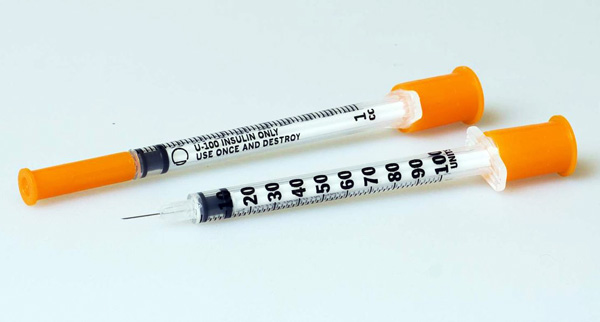
For botulinum therapy, 31G insulin syringes with a volume of 3 or 10 ml are used.
The location of specific points for the introduction of funds depends on the objectives of the procedure. So:
- To smooth the lower eyelid, 2 units of Botox or 5-6 units of Dysport are introduced 3 mm below the ciliary edge;
- To remove the "crow's feet", 3-5 injections of the drug are carried out around the outer edge of the eye 4-5 mm from it, with each injection 3-4 UNITS of Botox or 8-10 units of Dysport are introduced;
- The combination of injections around the outer corners of the eyes and the lower eyelid is necessary to increase the palpebral fissure by 2-3 mm with the parallel elimination of wrinkles in these areas;
- Rabbit wrinkles are removed by injecting 2-8 units of Botox into the skin on the bridge of the nose, and as high as possible and closer to the center line of the nose. The introduction of the drug near the inner corner of the eye is dangerous because of the risk of weakening the muscle that lifts the upper lip and wing of the nose, which will lead to a serious violation of facial expressions;
- To correct the asymmetry of the lower and upper eyelids, the drug can be administered along the entire perimeter of the circular muscle of the eye at those points and dosages that will allow you to correct a specific defect.
It is important to understand that there are no universal schemes for the location of injection points and quantities of the drug administered. There are general recommendations that a doctor should only consider as a guide for selecting a treatment regimen for a particular patient. Due to the individual characteristics of the anatomy of the eye, the location of the muscles, the strength of their contraction and the reaction to the drug for each person, the points of administration of the drug and the amount of Botox will vary. And the cosmetologist’s professionalism lies precisely in the ability to determine these points and dosages so precisely that the injection result is maximum while minimizing undesirable side effects.
In any case, with injections into the eyelids and around the eyes, the needle is inserted into the skin tangentially to the eyeball, and the doctor holds the patient’s head with his free hand. This prevents accidental movements and injury to the eyeball with a needle.

With the introduction of botulinum toxin, the syringe needle should be positioned tangentially to the eyeball.
On a note
Of course, Botox does not prick in the middle of the eye into the eyeball itself. Only the muscles around the eye are punctured, but in no case is the eye itself - at least there are no muscles in the eyeball, and it is absolutely pointless to inject the drug into it.
It is completely obvious that you can’t try to inject Botox yourself at home: any mistakes here are very dangerous not only with unpleasant consequences due to the action of the drug itself, but also with accidental injuries.
Does Botox hurt around the eyes?
Pricking Botox around the eyes is more painful than, for example, in the forehead or interbrow fold. This is due to the thinness of the skin and fat layer here, the proximity of nerve endings to the surface of the skin. Given this, cosmetologists usually perform local anesthesia of the injection area 20-30 minutes before the procedure or apply ice for 5-6 minutes before the injection.
It is proved that when Botox is dissolved in physiological saline without a preservative, injections will be more painful than when dissolved in a solution with a preservative. Therefore, for the introduction of the drug into the periorbital region, the doctor can prepare a separate solution to reduce the pain of injections.
Injections of some botulinum toxin preparations are by default more painful than others. For example, Relatox is known as one of the most “painful” drugs, although the cosmetic result of its administration is not much different from that with the introduction of Botox or, for example, Dysport. For this reason, Relatox is very rarely injected into the area around the eyes.

Relatox causes significant pain, unlike Botox, so it is infrequently injected into the periorbital region.
What should the patient do for maximum safety of injections?
A significant responsibility for the safety of the botulinum therapy procedure lies with the patient. In particular, he needs:
- To tell the cosmetologist as honestly as possible about taking certain medicines or about cosmetic surgeries (blepharoplasty, tightening) made earlier. Otherwise, the doctor will not be able to take into account important nuances in the diagnosis of wrinkles and the selection of points for the introduction of funds;
- To postpone the procedure if there is a clear contraindication. For example, there is no need to rush to do botulinum therapy with acute respiratory viral infections with high temperature, during pregnancy, or, for example, immediately after peeling;
- Follow the rules of rehabilitation after botulinum therapy. Despite the fact that some of these rules are considered obsolete and not mandatory, it is not worth violating them for maximum security. There is always a risk that you will find yourself the exception to the rule, for whom, for example, a glass of wine after the procedure will cause excessive Botox diffusion and the consequences associated with it.
Rehabilitation after Botox injections around the eyes requires special care, since it is in the periorbital region that tissues often swell, compensatory wrinkles develop and other complications appear. Therefore, after injections, you can’t lie down for 2 hours, sleep for 4 hours, you can not play sports during the day, bend over, sunbathe and take a hot bath. All these actions stimulate a stronger spread of Botox in the tissues than the doctor provides, with unpredictable consequences.
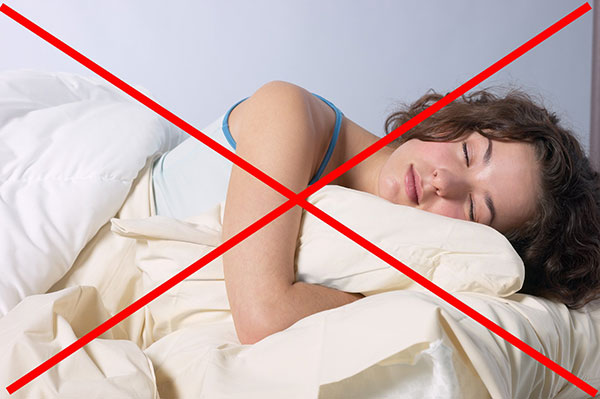
Within 4 hours after the botulinum treatment procedure, it is not recommended to go to bed.
An integrated approach to the elimination of cosmetic defects of periocular areas
In many cases, cosmetic defects in the eye area can be eliminated only by complex measures. At the same time, Botox can be both the main tool, supplemented by other drugs, and auxiliary.
The best combination is considered a combination of botulinum therapy with contouring. With it, static wrinkles, thinning of the skin and dents are corrected by fillers, and facial wrinkles are eliminated due to the action of botulinum toxin. In these cases, Botox is first injected, due to which the dynamic component of the defects of the periorbital region is eliminated, and contour plastic surgery is performed after 1-2 weeks. At the same time, Botox additionally protects the filler from dynamic deformation.
Botox is also an effective adjunct in surgical procedures to remove the lower eyelid ectropion and general blepharoplasty.Using botulinum toxin, you can correct the appearance of scars at the site of the surgical incision and relieve tension at the site of excision of the skin.
It is useful to supplement botulinum therapy of the periorbital region with topical retinoids, which rejuvenate the skin, reduce the adhesion of cells of the upper layers of the epidermis and weaken the severity of small static wrinkles. Also, a pronounced positive result is provided by laser and light therapy of the skin 10-15 days after botulinum therapy.
An interesting video about the correction of facial wrinkles using the local administration of microdoses of botulinum toxin preparations with the explanations of a cosmetologist
Swelling around the eyes after botulinum therapy. What to do? Specialist advice



